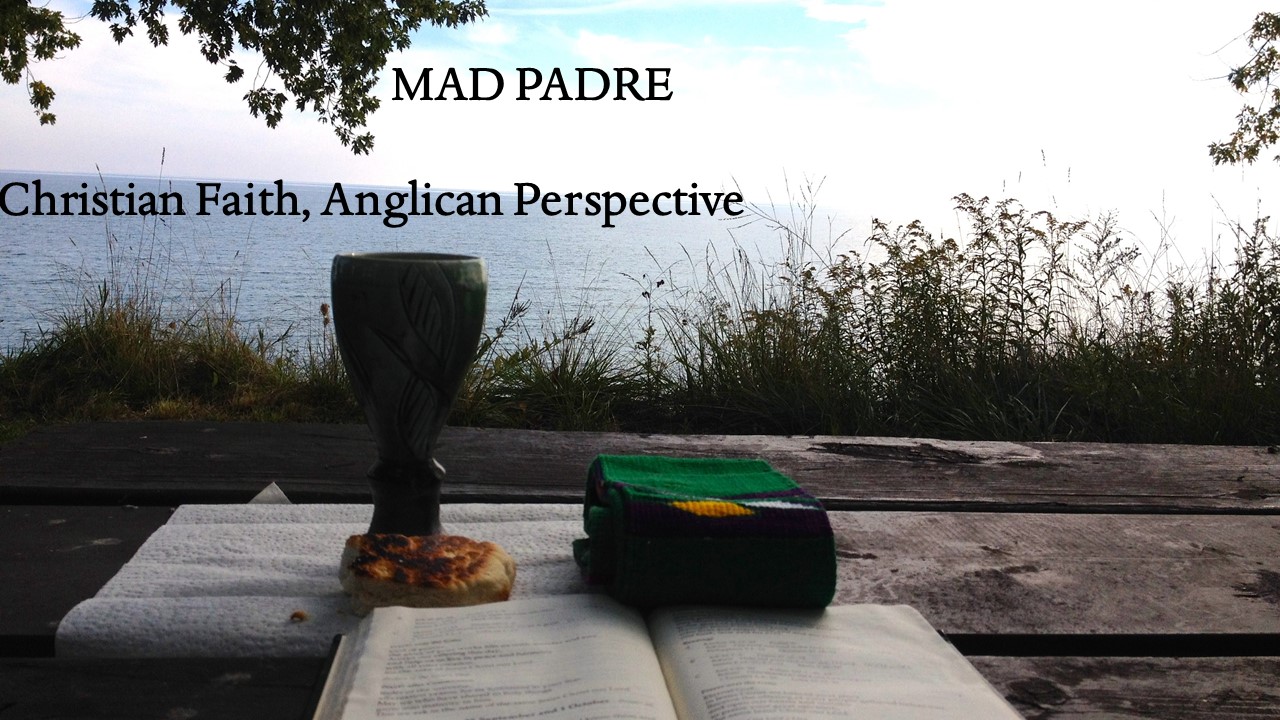Friday, February 27, 2009
A model of biblical proportions
This story combines the Mad Padre's love of a) things religious with b) things historical with c) crazy modeling pursuits. As a friend of mine commented, when the English farmer who built this massive model of King Herod's temple dies, his long-suffering wife should open it to tourists and charge admission. Has to be seen to be believed.
Thursday, February 26, 2009
Where Is God On This Bus?
In Halifax, here in Nova Scotia, a debate is currently raging over the decision of the city's transit authority to reject an ad campaign by a Freethought, an organization dedicated to atheism. I don't know much about Freethought, but I gather that it's protesting the Transit company's recent decision to reject another ad campaign by Humanist Canada dedicated to the excellent question, "Can We Be Good Without God"?

Here is today's Chronicle Herald's editorial on the subject:
Metro Transit within rights to reject atheist ads
Thu. Feb 26 - 7:06 AM
THIS we can all agree on: Metro Transit’s core business is commuters, not communications. For years now, city buses have sold advertising on the side, quite literally. But buses are not what immediately spring to mind as vehicles for free expression – like newspapers.
So it’s to be expected that a private publication and a public transit company might have different standards when it comes to accepting or rejecting ad content. Would The Chronicle Herald run an ad from the Freethought Association of Canada that reads: "There’s probably no God. Now stop worrying and enjoy your life"? The answer is yes. It would also run the ad from Humanist Canada, "You can be good without God," which Metro Transit rejected earlier this month.
But Metro Transit, which has Pattison Outdoor Advertising handling its ad business, is within its rights to ultimately turn down such ads. Like The Chronicle Herald, it retains sole discretion over the content it chooses to display. Metro Transit’s policy is to steer clear of ads it deems controversial, and if it doesn’t want to touch religious or anti-religious ads with a 10-foot pole, so be it.
Nowhere does it say that the Freethought Association has the right – God-given or not – to have its ad run on buses any more than a reader has a right to have his letter to the editor published. The fact that Metro Transit is a public service subsidized by taxpayers is immaterial. The CBC is taxpayer-funded, too, yet is under no obligation to make room for every type of advertiser.
Freethought, which staged a demonstration at Halifax city hall on Tuesday, is going overboard by turning this into a "free speech issue" worthy of litigation. It’s hard to claim freedom of expression is at stake when other outlets are willing to run your ad and your protest makes front-page news.
Metro Transit is not quashing free speech. It is merely saying it does not want to get involved in this debate. It knows that an atheist-themed ad is "objectionable" to certain people, and does not want that impacting on its ridership. It also knows that running such an ad will inevitably invite a response from the other side – perhaps an ad that reads: "Are you right with God? Better find out before you die." That might start a whole new cycle of objections. Pretty soon, the pro-life and anti-abortion lobbies would be buying duelling ads on buses and public transit would be a perpetual commotion machine.
All these issues are – and deserve to be – fully and openly discussed in our society. But if the bus company does not want to be a hub for philosophical and religious debate, who can blame it?
Finally, two editorial cartoons on the matter, one from the Chronicle Herald:

And one from the Ottawa Citizen courtesy of my brother the Mad Colonel:

The Mad Colonel also put me on to this counter-campaign by an English evangelist, Gerald Coates:

Always nice to see a healthy debate, even if it isn't allowed on the buses. For my own part, I'll confine myself to saying in response to that other debate, What Would Jesus Drive?, that he wouldn't drive, he'd take public transit.

Here is today's Chronicle Herald's editorial on the subject:
Metro Transit within rights to reject atheist ads
Thu. Feb 26 - 7:06 AM
THIS we can all agree on: Metro Transit’s core business is commuters, not communications. For years now, city buses have sold advertising on the side, quite literally. But buses are not what immediately spring to mind as vehicles for free expression – like newspapers.
So it’s to be expected that a private publication and a public transit company might have different standards when it comes to accepting or rejecting ad content. Would The Chronicle Herald run an ad from the Freethought Association of Canada that reads: "There’s probably no God. Now stop worrying and enjoy your life"? The answer is yes. It would also run the ad from Humanist Canada, "You can be good without God," which Metro Transit rejected earlier this month.
But Metro Transit, which has Pattison Outdoor Advertising handling its ad business, is within its rights to ultimately turn down such ads. Like The Chronicle Herald, it retains sole discretion over the content it chooses to display. Metro Transit’s policy is to steer clear of ads it deems controversial, and if it doesn’t want to touch religious or anti-religious ads with a 10-foot pole, so be it.
Nowhere does it say that the Freethought Association has the right – God-given or not – to have its ad run on buses any more than a reader has a right to have his letter to the editor published. The fact that Metro Transit is a public service subsidized by taxpayers is immaterial. The CBC is taxpayer-funded, too, yet is under no obligation to make room for every type of advertiser.
Freethought, which staged a demonstration at Halifax city hall on Tuesday, is going overboard by turning this into a "free speech issue" worthy of litigation. It’s hard to claim freedom of expression is at stake when other outlets are willing to run your ad and your protest makes front-page news.
Metro Transit is not quashing free speech. It is merely saying it does not want to get involved in this debate. It knows that an atheist-themed ad is "objectionable" to certain people, and does not want that impacting on its ridership. It also knows that running such an ad will inevitably invite a response from the other side – perhaps an ad that reads: "Are you right with God? Better find out before you die." That might start a whole new cycle of objections. Pretty soon, the pro-life and anti-abortion lobbies would be buying duelling ads on buses and public transit would be a perpetual commotion machine.
All these issues are – and deserve to be – fully and openly discussed in our society. But if the bus company does not want to be a hub for philosophical and religious debate, who can blame it?
Finally, two editorial cartoons on the matter, one from the Chronicle Herald:

And one from the Ottawa Citizen courtesy of my brother the Mad Colonel:

The Mad Colonel also put me on to this counter-campaign by an English evangelist, Gerald Coates:

Always nice to see a healthy debate, even if it isn't allowed on the buses. For my own part, I'll confine myself to saying in response to that other debate, What Would Jesus Drive?, that he wouldn't drive, he'd take public transit.
Tuesday, February 24, 2009
Battle Report - American Civil War Game
One of my Christmas presents to myself was the set of American Civil War miniatures rules, They Couldn't Hit an Elephant, published by Too Fat Lardies. Like other TFL systems, these rules emphasize command and control and the friction of battle through command points for leaders and cards that activate units and leaders in a somewhat random manner.
For this game, my son John and I put my entire ACW collection of 25 to 28mm figures on the table. We used the TCHAE random leader generator for 1865, and managed to get a bunch of second rate leaders (John says his leaders were worse than mine). We had two brigades (five regiments total) and two 3 gun batteries each. Probably we had too many leaders (two brigadiers and one divisional commander) and were so spared some bad command and control headaches. We each took two real blinds and one dummy, though John chose to use his dummy blind to group his two batteries of rifled cannon together.
In our little battle, John was represented on the table by General Jebediah Smith, an Inexperienced commander, and his two subordinates, Brigadier Whitewall and another guy so forgettable that his name is already lost to history. My CinC was General Thaddeus P. Cornpone, a Cautious Inexperienced commander, General Lone Star, an Inexperienced commander, and General Stanley McWhiskers, a Professional commander.
John's Union forces enter the table under blinds. My confederate commanders would do a lousy job of spotting them.
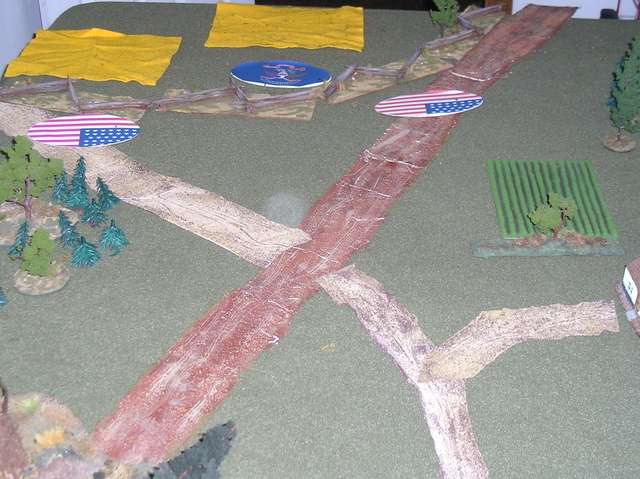
John spots the Mississipi brigade of General Stanley McWhiskers (named in honour of our newest cat) advancing in column of march. Once a force on a blind is spotted, it must be deployed on the table.
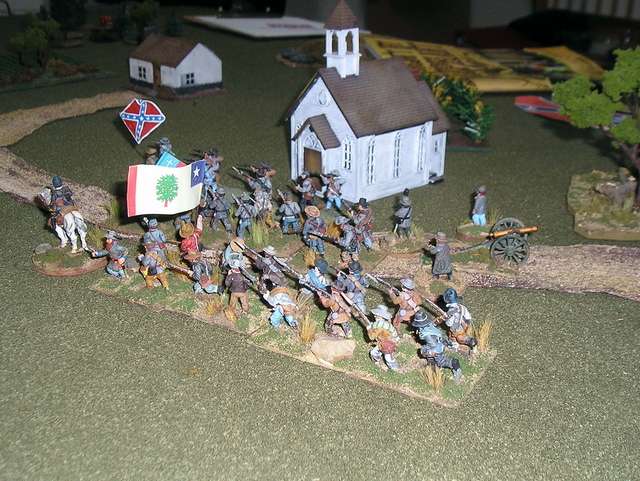
The cards favour one of my brigades, the Texans under General "Lone" Star, who claims what will soon become a strategic hill.

John spots the Texan brigade and they are deployed on their hill. A Union blind is coming up fast against them - it is a dummy? I haven't been able to spot it yet.

The Texans prepare to hold. The figures are mostly Old Glory - the artillery commander and the chap on the horse in the background are Dixon figures.
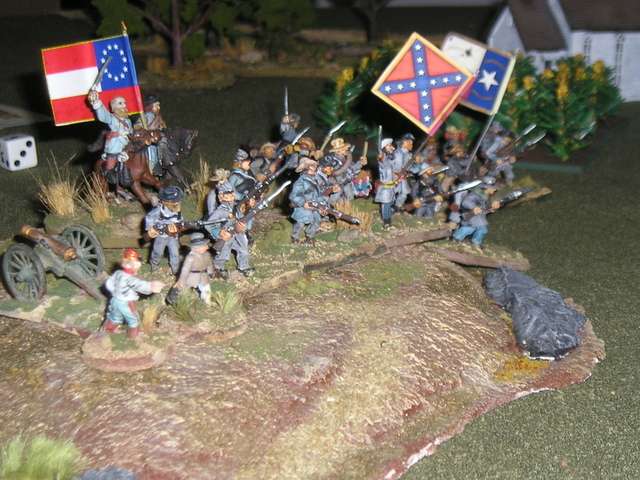
John reveals his brigade from its blind and throws it into battle. The lead regiment are painted as the Union Iron Brigade and are a mix of Wargames Foundry and Old glory figures. The lovely flags are from GMB designs. John lead with the men of the Iron Brigade and supported them with the Irish of the 69th New York. Like many Civil War commanders new to the battlefield, John found it hard to coordinate his attacks. At this point John realized that not allocating his batteries to direct support of his infantry brigades was probably not a good idea. The hill advantage to the defending Texans certainly worked against John's bluebellies.
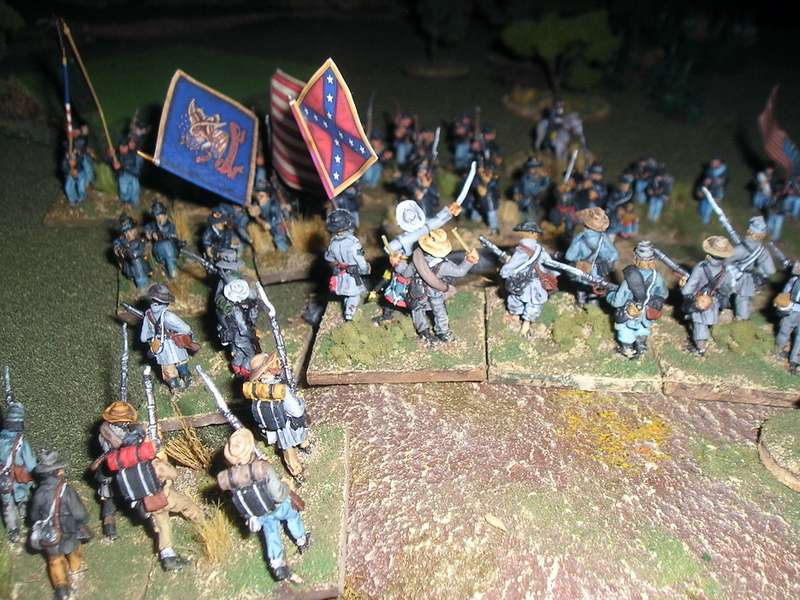
Union troops storming up the hill, braving showers of close range cannister from the Confederate battery (second rate smoothbores but still deadly at close range).
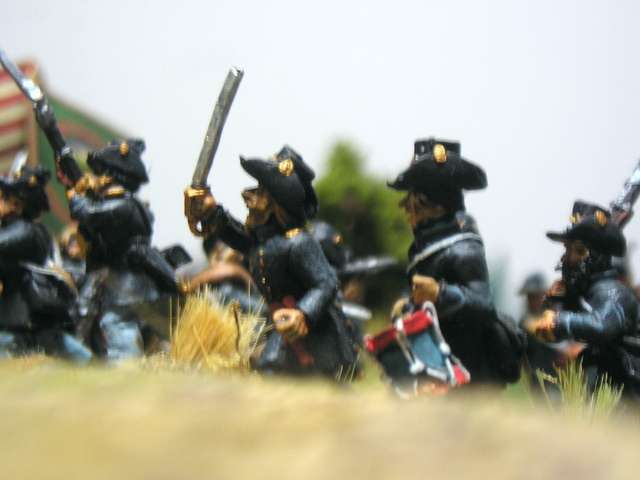
"Hold 'em, boys!" General Star anchors his two regiments of veteran Texans. He would lead a charmed life in this game.

In the centre of the table, John's massed Union battery comes of its blind and engages the skirmishers screening the advance of McWhisker's Mississipi brigade. the artillerists are Wargames Foundry - the Union infantry in the background are ancient Minifigs figures I started painting back during the first Gulf War. One of the rules we forgot was the ability of commanders to use their command pips to direct the fire of artillery more effectively. We both had commanders to spare and they might have made the artillery fire more effective.

John's other brigade, two regiments of average Union infantry, comes off its blind facing McWhisker's brigade. With his next card, John would adroitly move this brigade to completely flank McWhiskers.
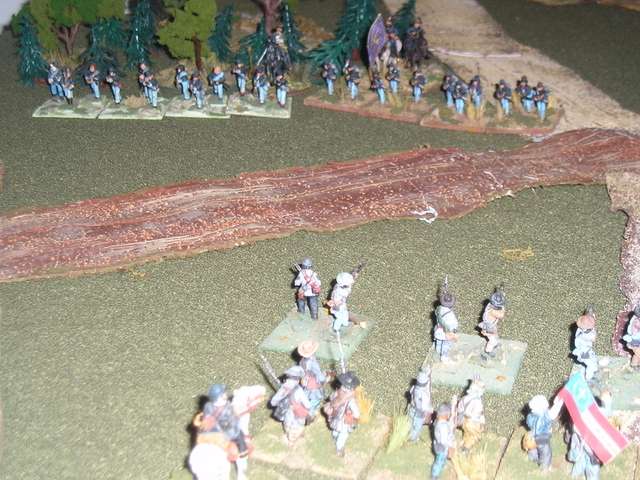
On the hill, the Iron Brigade has been thrown back with heavy losses, interpenetrating and disordering the 69th NY which was supporting its attack. Lone Star seizes the moment to throw the supporting 4th Texas down the hill and into the Irish ranks. Isn't that little outhouse in the background the cutest thing? Another thing we forgot was the rule whereby victorious units have to test to see if they will pursue routing units. There were several charges and routs in the game where pursuits might have made a difference either way.
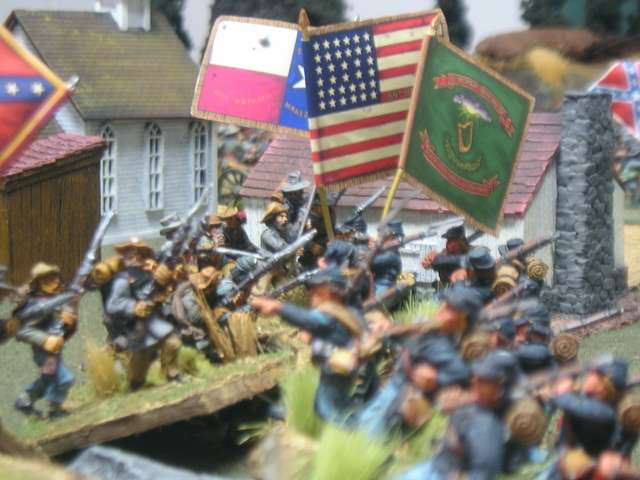
Meanwhile, disaster on my left flank. The Union brigade is lucky with its cards, and hits the leading two of McWhiskers' three regiments in their flank, routing them towards the Confederate centre. Those Yankees may be old Minifigs, but they're deadly in a flank attack.

John's luck runs out. The next card favours McWhiskers, who countercharges with his one intact regiment of Mississipians. They stop the Union brigade and throw it back towards its artillery.
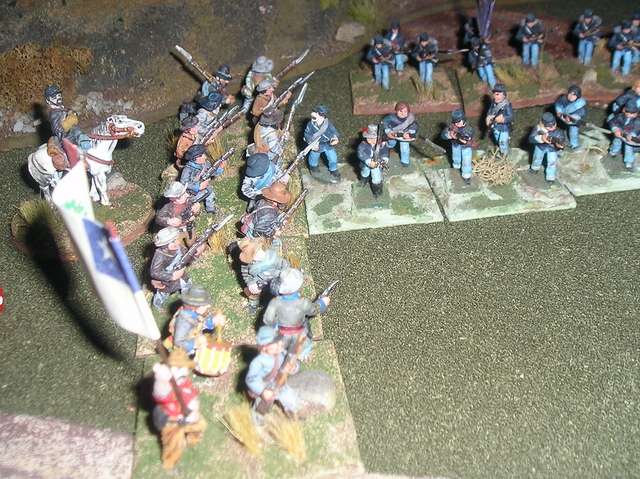
On the right flank, John's Yankees are busy skeddadling. His general tries to rally them with cries of "Think of your mothers, boys, what would they say?" but to no avail. Lone Star drives the routing bluebellies off the board with his Texans. In these rules, once a unit falls below half strength, it's pretty much toast.
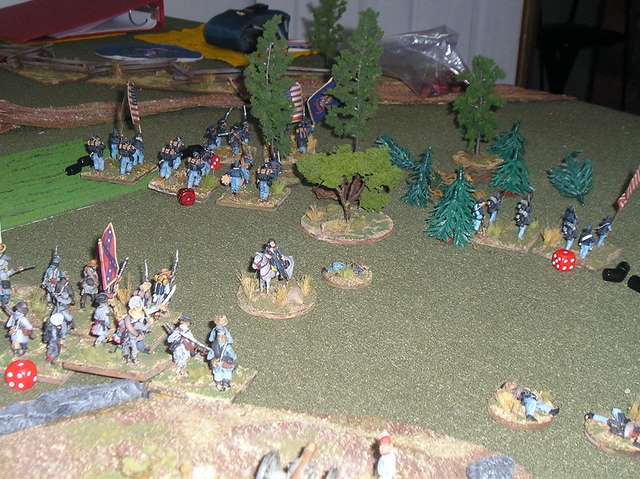
In the center, Genl. Cornpone was able to rally McWhiskers' routing regiments, while John had rallied his boys, and so a standoff developed on the left flank. However, the battered but victorious Texans were now threatening the Union batteries in the centre, forcing them to limber up and, says John, "strategically redeploy" rather than retreating. However, sadly for the Union, once limbered they were attractive targets for the Confederate gunners, and within minutes half the Union guns were knocked out. At this point, we called it a day. Jebediah Smith would withdraw and write a report to Abe Lincoln citing "unfortunate circumstances" as the reason for his delay in subduing the rebel forces and asking for immediate reinforcements. General Cornpone would send a report to Richmond simply saying "We whupped 'em good. Good fight. Too mussed up to chase 'em though".
Here the happy generals, clad in Dad's civil war reeneacting gear, pose for the newspapers.

Concluding thoughts - we both liked these rules. They were simple enough to be playable and they gave us a good game. We both felt some of the frustrations of the civil war battlefield. Even as I write this, new figures are being painted for the rematch. Will Jebediah Smith be able to turn the tables on Cornpone and drive him back to Richmond?
For this game, my son John and I put my entire ACW collection of 25 to 28mm figures on the table. We used the TCHAE random leader generator for 1865, and managed to get a bunch of second rate leaders (John says his leaders were worse than mine). We had two brigades (five regiments total) and two 3 gun batteries each. Probably we had too many leaders (two brigadiers and one divisional commander) and were so spared some bad command and control headaches. We each took two real blinds and one dummy, though John chose to use his dummy blind to group his two batteries of rifled cannon together.
In our little battle, John was represented on the table by General Jebediah Smith, an Inexperienced commander, and his two subordinates, Brigadier Whitewall and another guy so forgettable that his name is already lost to history. My CinC was General Thaddeus P. Cornpone, a Cautious Inexperienced commander, General Lone Star, an Inexperienced commander, and General Stanley McWhiskers, a Professional commander.
John's Union forces enter the table under blinds. My confederate commanders would do a lousy job of spotting them.

John spots the Mississipi brigade of General Stanley McWhiskers (named in honour of our newest cat) advancing in column of march. Once a force on a blind is spotted, it must be deployed on the table.

The cards favour one of my brigades, the Texans under General "Lone" Star, who claims what will soon become a strategic hill.

John spots the Texan brigade and they are deployed on their hill. A Union blind is coming up fast against them - it is a dummy? I haven't been able to spot it yet.

The Texans prepare to hold. The figures are mostly Old Glory - the artillery commander and the chap on the horse in the background are Dixon figures.

John reveals his brigade from its blind and throws it into battle. The lead regiment are painted as the Union Iron Brigade and are a mix of Wargames Foundry and Old glory figures. The lovely flags are from GMB designs. John lead with the men of the Iron Brigade and supported them with the Irish of the 69th New York. Like many Civil War commanders new to the battlefield, John found it hard to coordinate his attacks. At this point John realized that not allocating his batteries to direct support of his infantry brigades was probably not a good idea. The hill advantage to the defending Texans certainly worked against John's bluebellies.

Union troops storming up the hill, braving showers of close range cannister from the Confederate battery (second rate smoothbores but still deadly at close range).

"Hold 'em, boys!" General Star anchors his two regiments of veteran Texans. He would lead a charmed life in this game.

In the centre of the table, John's massed Union battery comes of its blind and engages the skirmishers screening the advance of McWhisker's Mississipi brigade. the artillerists are Wargames Foundry - the Union infantry in the background are ancient Minifigs figures I started painting back during the first Gulf War. One of the rules we forgot was the ability of commanders to use their command pips to direct the fire of artillery more effectively. We both had commanders to spare and they might have made the artillery fire more effective.

John's other brigade, two regiments of average Union infantry, comes off its blind facing McWhisker's brigade. With his next card, John would adroitly move this brigade to completely flank McWhiskers.

On the hill, the Iron Brigade has been thrown back with heavy losses, interpenetrating and disordering the 69th NY which was supporting its attack. Lone Star seizes the moment to throw the supporting 4th Texas down the hill and into the Irish ranks. Isn't that little outhouse in the background the cutest thing? Another thing we forgot was the rule whereby victorious units have to test to see if they will pursue routing units. There were several charges and routs in the game where pursuits might have made a difference either way.

Meanwhile, disaster on my left flank. The Union brigade is lucky with its cards, and hits the leading two of McWhiskers' three regiments in their flank, routing them towards the Confederate centre. Those Yankees may be old Minifigs, but they're deadly in a flank attack.

John's luck runs out. The next card favours McWhiskers, who countercharges with his one intact regiment of Mississipians. They stop the Union brigade and throw it back towards its artillery.

On the right flank, John's Yankees are busy skeddadling. His general tries to rally them with cries of "Think of your mothers, boys, what would they say?" but to no avail. Lone Star drives the routing bluebellies off the board with his Texans. In these rules, once a unit falls below half strength, it's pretty much toast.

In the center, Genl. Cornpone was able to rally McWhiskers' routing regiments, while John had rallied his boys, and so a standoff developed on the left flank. However, the battered but victorious Texans were now threatening the Union batteries in the centre, forcing them to limber up and, says John, "strategically redeploy" rather than retreating. However, sadly for the Union, once limbered they were attractive targets for the Confederate gunners, and within minutes half the Union guns were knocked out. At this point, we called it a day. Jebediah Smith would withdraw and write a report to Abe Lincoln citing "unfortunate circumstances" as the reason for his delay in subduing the rebel forces and asking for immediate reinforcements. General Cornpone would send a report to Richmond simply saying "We whupped 'em good. Good fight. Too mussed up to chase 'em though".
Here the happy generals, clad in Dad's civil war reeneacting gear, pose for the newspapers.

Concluding thoughts - we both liked these rules. They were simple enough to be playable and they gave us a good game. We both felt some of the frustrations of the civil war battlefield. Even as I write this, new figures are being painted for the rematch. Will Jebediah Smith be able to turn the tables on Cornpone and drive him back to Richmond?
Thursday, February 19, 2009
A glimpse of how another NATO country announces Afghanistan casulaites
It's probably news to most people that the British military has been taking a steady number of casualties as they are aggressively engaging the Taliban in Helmand province in Afghanistan. One of the things I admire about the British Ministry of Defence is the substantial press releases they offer after losing soldiers. Each press release offers a glimpse of a real person, including often humourous anecdotes from his comrades. This example of a Rifleman, Lance Corporal Kingscott, is typical. You have to love the fact that the article does not shy away from using his nickname, "Schnoz". There's much to admire here, and hopefully our military PR folks can take note.
Lance Corporal Stephen Kingscott killed in Afghanistan
A Military Operations news article
17 Feb 09
It is with deep regret that the Ministry of Defence must confirm the death of Lance Corporal Stephen Kingscott of 1st Battalion The Rifles in Afghanistan on 16 February 2009.

Lance Corporal Stephen Kingscott of 1st Battalion The Rifles
[Picture: via MOD]
Lance Corporal Kingscott died during the assault of an enemy position during a deliberate operation against insurgents in the Nawa district of Helmand province.
Lance Corporal Stephen 'Schnoz' Kingscott of 1st Battalion The Rifles
Stephen Michael Kingscott was born on 10 July 1986 at the Freedom Fields Hospital in his hometown of Plymouth.
Read the complete article.
Lance Corporal Stephen Kingscott killed in Afghanistan
A Military Operations news article
17 Feb 09
It is with deep regret that the Ministry of Defence must confirm the death of Lance Corporal Stephen Kingscott of 1st Battalion The Rifles in Afghanistan on 16 February 2009.

Lance Corporal Stephen Kingscott of 1st Battalion The Rifles
[Picture: via MOD]
Lance Corporal Kingscott died during the assault of an enemy position during a deliberate operation against insurgents in the Nawa district of Helmand province.
Lance Corporal Stephen 'Schnoz' Kingscott of 1st Battalion The Rifles
Stephen Michael Kingscott was born on 10 July 1986 at the Freedom Fields Hospital in his hometown of Plymouth.
Read the complete article.
Sunday, February 8, 2009
Work in Progress - 25mm ACW Rebel Infantry
These chaps have been kicking around my collection for several years. Started them, did a rubbish job, laid them down in disgust, moved twice, and now I've got a major jones on for the ACW again and I'm getting them finished ASAP. Most of them are Redoubt, which makes a yummy ACW line, and a few, the tall thin guys with the packs, are Old Glory. The Redoubt figures are in various skirmish postures. They'll look great behind the stone wall sections I have coming from Hovels in the UK, via the Michigan Toy Soldier store.
Personally I find painting rebs a pain. I can't just paint them grey. I've spent too many years in ACW reenacting to do that. There is too much variety in uniform, various shades of grey and brown (the famous butternut) plus some captured Union gear plus civilian shirts, blankets, hats, etc. It does slow down the job of painting, but the work is more interesting, I suppose.
You'll have to click on each photo to see the complete image.
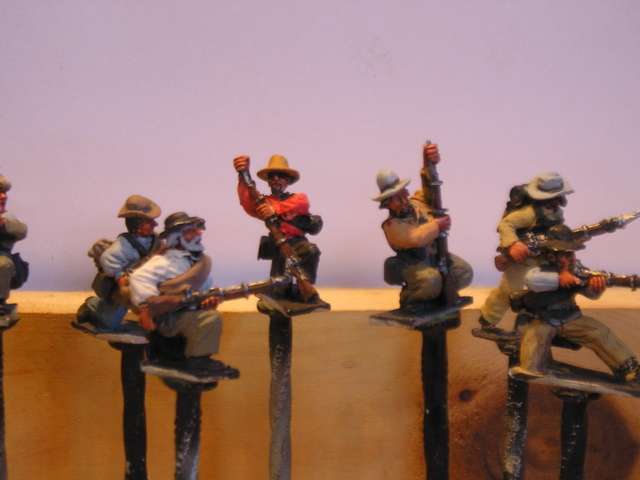
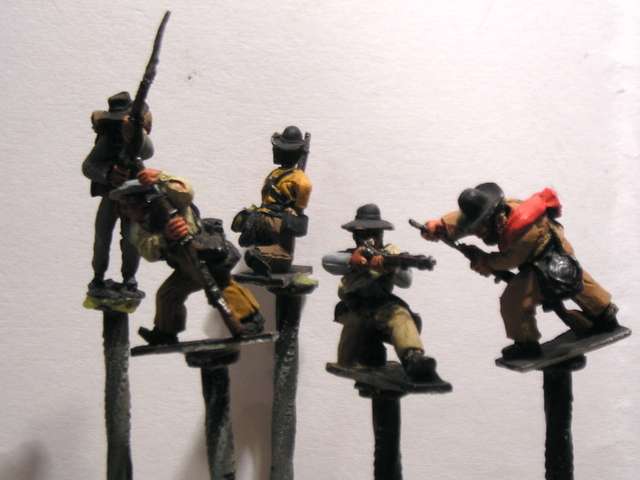
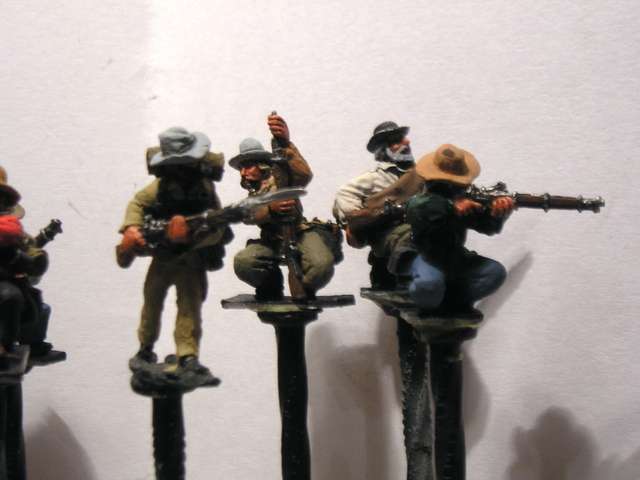

Personally I find painting rebs a pain. I can't just paint them grey. I've spent too many years in ACW reenacting to do that. There is too much variety in uniform, various shades of grey and brown (the famous butternut) plus some captured Union gear plus civilian shirts, blankets, hats, etc. It does slow down the job of painting, but the work is more interesting, I suppose.
You'll have to click on each photo to see the complete image.




Some Terrain Efforts
Some of the more recent things off my workbench.
First, an idea that's been kicking around my head for a while - a way to make cornfields for American Civil War 25mm collection. I drilled holes in a sheet of
1/4" pressboard, trimmed lenghts of artificial Christmas garland, and voila. Ms. Padre things they look more like they belong in a Vietnam jungle then they do at Antietam. She's probably right, but for now they serve a need and I'll probably make more of them:

In a different vein, I recently finished these these three plaster ruined buildings in 15mm scale for my WW2 collection, bought when I was at the Hotlead game convention in Stratford, Ontario, last year. I have no idea who the manufacturer is. I thought at the time they all looked suitable for my Normandy project, but on closer inspection, two look like they belong in Italy. No matter. I can use them too, somewhere. I just have to paint my Battlefront mid war British infantry company as Canadian 1 Division, buy some German paratroopers, a lot of armoured kit for them, and ... my God, someone shoot me.
The NW Europe style ruin:
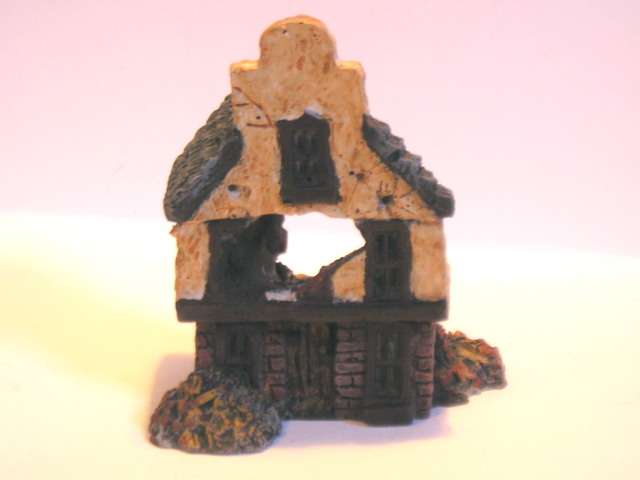

And the two Italian jobs:


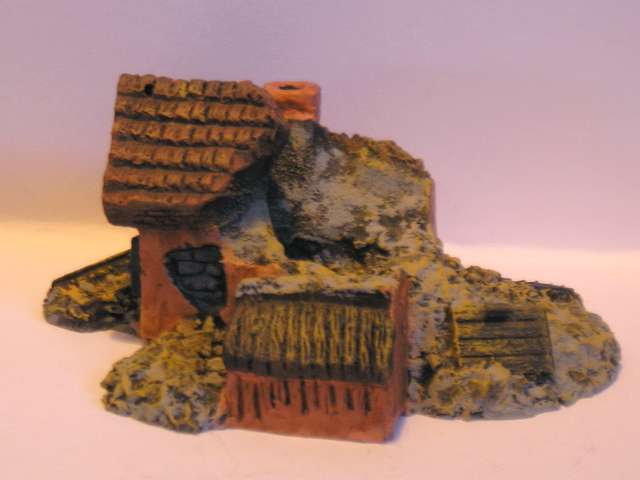
First, an idea that's been kicking around my head for a while - a way to make cornfields for American Civil War 25mm collection. I drilled holes in a sheet of
1/4" pressboard, trimmed lenghts of artificial Christmas garland, and voila. Ms. Padre things they look more like they belong in a Vietnam jungle then they do at Antietam. She's probably right, but for now they serve a need and I'll probably make more of them:

In a different vein, I recently finished these these three plaster ruined buildings in 15mm scale for my WW2 collection, bought when I was at the Hotlead game convention in Stratford, Ontario, last year. I have no idea who the manufacturer is. I thought at the time they all looked suitable for my Normandy project, but on closer inspection, two look like they belong in Italy. No matter. I can use them too, somewhere. I just have to paint my Battlefront mid war British infantry company as Canadian 1 Division, buy some German paratroopers, a lot of armoured kit for them, and ... my God, someone shoot me.
The NW Europe style ruin:


And the two Italian jobs:



Wednesday, February 4, 2009
British Military Chaplaincy Holds First Ever Armed Forces Sikh Prayer Day
The UK MOD news blog often offers fascinating items, and this story is of interest to those in military chaplaincy who are trying to make interfaith chaplaincy viable in a post-Christendom age. This story from today's blog offers an example of what interfaith chaplaincy looks like.
First Forces' Sikh Prayer Day a success
A People In Defence news article
3 Feb 09
Forty Sikh members of the armed forces gathered at a Sikh temple near Reading for the first ever Armed Forces' Sikh Prayer Day on Saturday 31 January 2009.

Captain Amarjit 'Gilly' Singh bows before the Sikh holy book, the Guru Granth Sahib, during the first Armed Forces' Sikh Prayer Day
[Picture: Chris Fletcher]
There are currently around 200 Sikhs serving in Britain's armed forces, spread thinly across the three Services. Coming from a religion with a strong sense of community, some Sikh servicemen and women can feel isolated without fellow Sikhs to meet or pray with, so a call went out from some of those serving for a day of prayer and celebration of their faith.
That call was answered by Mandeep Kaur, the Sikh civilian chaplain to the military. Mandeep organised the congregation in celebration of the birthday of the tenth Sikh Guru, Guru Gobind Singh.
Read the Whole Article
First Forces' Sikh Prayer Day a success
A People In Defence news article
3 Feb 09
Forty Sikh members of the armed forces gathered at a Sikh temple near Reading for the first ever Armed Forces' Sikh Prayer Day on Saturday 31 January 2009.

Captain Amarjit 'Gilly' Singh bows before the Sikh holy book, the Guru Granth Sahib, during the first Armed Forces' Sikh Prayer Day
[Picture: Chris Fletcher]
There are currently around 200 Sikhs serving in Britain's armed forces, spread thinly across the three Services. Coming from a religion with a strong sense of community, some Sikh servicemen and women can feel isolated without fellow Sikhs to meet or pray with, so a call went out from some of those serving for a day of prayer and celebration of their faith.
That call was answered by Mandeep Kaur, the Sikh civilian chaplain to the military. Mandeep organised the congregation in celebration of the birthday of the tenth Sikh Guru, Guru Gobind Singh.
Read the Whole Article
Canadian Soldier Killed in Afghanistan
DND announced on January 31st that Sapper Sean Greenfield was killed that day in Afghanistan when the vehicle he was riding in struck a roadside bomb.

The other occupants of the vehicle were assessed and returned to duty. A difficult day for them, to be sure. Greenfield was a sapper, which in army vocabulary means an engineer. He served with 24 Field Engineer Squadron, 2 Combat Engineer Regiment, based at CFB Petawawa. He was 25 years old and was from Pinawa, Manitoba. CBC news reported that Greenfield was known by his comrades for singing and playing his guitar. His body returned home to Canada yesterday at CFB Trenton.
Sapper Greenfield is the 108th Canadian soldier to have died in service of his country in Afghanistan. Rest eternal grant unto him, O Lord, and may light perpetual shine upon him.

The other occupants of the vehicle were assessed and returned to duty. A difficult day for them, to be sure. Greenfield was a sapper, which in army vocabulary means an engineer. He served with 24 Field Engineer Squadron, 2 Combat Engineer Regiment, based at CFB Petawawa. He was 25 years old and was from Pinawa, Manitoba. CBC news reported that Greenfield was known by his comrades for singing and playing his guitar. His body returned home to Canada yesterday at CFB Trenton.
Sapper Greenfield is the 108th Canadian soldier to have died in service of his country in Afghanistan. Rest eternal grant unto him, O Lord, and may light perpetual shine upon him.
Tuesday, February 3, 2009
Military Picture of the Day
This image of the day from today's United Kingdom Ministry of Defence blog is too good to pass up.

The official caption mentions that even the Life Guards Squadron of the Household Cavalry Mounted Regiment have to ride to work in the snow. Several friends of mine have remarked that the onlookers seem more interested in the horse poop in the snow. And what is that guy doing there on the right wearing Canadian cadpat at Horse Guards?
The official caption mentions that even the Life Guards Squadron of the Household Cavalry Mounted Regiment have to ride to work in the snow. Several friends of mine have remarked that the onlookers seem more interested in the horse poop in the snow. And what is that guy doing there on the right wearing Canadian cadpat at Horse Guards?
Sunday, February 1, 2009
Words of Authority: A Sermon for the Fourth Sunday of Epiphany

Preached at St. Mark’s Chapel, CFB Greenwood, 1 February, 2009
Deuteronomy 18:15-20, Psalm 111, 1 Corinthians 8:1-13, Mark : 21-28
This week I met that kind and gallant chaplain, Padre Foz, and he asked me if I could use a break from preaching, since I’m currently tasked to take full time French language training. “Mon Dieu, mais non, Monsieur!” I said (and of course I said it in French). I thanked Foz for his very kind offer, but insisted that its important for me to preach on a regular basis. Preaching, I said, is like any other skill or discipline, and needs to be practiced. After saying goodbye to Foz and looking at the readings for this Sunday, I thought to myself, “Mon Dieu, what have I got myself into?”
Today’s first lesson contains words that should strike fear into any preacher’s heart. In this passage from Deuteronomy, the dying Moses is giving words of instruction to the people of Israel before they cross into the promised land. God, he promises them, will send the Israelites prophets to continue to lead them. God will give these prophets words so that they “shall speak ... everything that I command”. Well, so far so good, I thought to myself. But then comes the kicker. Moses warns that “any prophet who speaks in the name of other gods, or who presumes to speak in my name a word that I have not commanded the prophet to speak – that prophet shall die” (Deut 8:20). Reading that passage makes me want to back away slowly from the pulpit, and, like Buggs Bunny in the famous cartoon “What’s Opera, Doc?”, say “Bye-yee!” and vanish into hiding.

If you were listening to the first lesson, you should have also had a nervous moment, because Moses has words of warning for congregations as well as for preachers. As Moses tells the Israelites, God has warned that “Anyone who does not heed the words that the prophet shall speak in my name, I myself will hold accountable” (Deut 18:19). That passage puts a heavy weight of responsibility on listeners as well as preachers. It reminds us that we are all engaged in a serious business, and that the sermon is taking us into places where angels fear to tread. Are you sure you want to stay and listen, or should we just go for coffee now and call it a day?
Why don’t we stay and risk it, and consider, first of all, why we take this risk, Sunday by Sunday, of hoping to hear the voice of God. After all, it is a risky business, and we’d be foolish to forget that fact. At the beginning of our first lesson, Moses asks the Israelites to remember the time when God spoke to them from the heights of Mount Sinai, referred to here by its other name of Mount Horeb. “This is what you requested of the Lord your God at Horeb on the day of the assembly, when you said: “If I hear the voice of the Lord my God any more, or ever again see this great fire, I will die” (Deut 18:16). If we go back to the original story in Exodus of Mount Sinai and God’s gift of the Ten Commandments to Israel, we find that it was a pretty scary time. The mountain was wreathed in smoke and was shaking, God’s voice was like thunder, and the people were told to stay away lest they perish.
However, it was all for a purpose. God gave a way of life to the Israelites, that they were to follow. They were to worship God and keep his laws, and were not to follow the false gods of neighbouring peoples. In return , God would make this group of escaped slaves into a blessing for the whole world. “Now therefore, if you obey my voice and keep my covenant, you shall be my treasured possession out of all the peoples. Indeed, the whole earth is mind, but you shall be for me a priestly kingdom and a holy nation” (Exodus 19:5-6). In other words, Israel’s job was to lead by example. They were to show the rest of world that living in a relationship with God was the best possible life, the greatest blessing, that the world could imagine. Israel had been brought out of slavery, and this covenant relationship with God would keep them free.

Sunrise at Jebel Musa in the Sinai Peninsula
Hopefully this passage puts your mind at ease. Knowing the context behind today’s first lesson, we can be reassured that we are gathered here as part of God’s plan to make us a priestly kingdom and a holy nation. We are here because we have been called in our turn to be part of God’s people, to do our part in showing God’s love to a hurting world, and to invite others to come and joins us as God’s people. But what about those dire warnings in our first lesson about what happens when we get it wrong as preachers and as congregations? Is God really going to punish us if we make a mistake in speaking or in listening, if we fail to get it right? It rather seems like we are on a pretty narrow spiritual path, with danger lurking on either side if we get it wrong.
So with these dangers in mind, how do we know when we are hearing an authentic voice of prophecy? How do we know when we are hearing God’s voice? After all, not all preachers come across with the authority of a Moses or a Billy Graham.

There are a lot of competing voices out there. Within Christian churches we find many different calls to follow God in different ways. Some ask us to embrace the world and be tolerant to other faiths. Others warn their followers to turn away from the world and from non-believers. Our second lesson is an example of a competition, as Paul writes to Christians in Corinth who are worried about how they can get along with neighbours who dedicate their lives and their meals to other gods. In bookstores there are many different prophets in the self-help section, like Rhonda Byrne’s bestselling book, The Secret, or Bruce Wilkinson`s The Prayer of Jabez, which both promise security and prosperity if we just ask for the things we want. Which prophets do we follow?
The answer is blessedly simply. We need to follow prophets who point us to Jesus Christ, the Son of God and to his words. There are many words in the world. There are many words in churches. But only the words of Christ have power to save us and to make us into what God wants us to be, his people. Notice how the word authority runs throughout our gospel lesson (Mark 1:21-28). The people in the synagogue in Capernaum recognize Jesus as having an authority that is missing in their own teachers. The unclean spirit in the possessed man recognizes that Jesus is “the Holy One of God” and obeys Jesus’ command to leave the man. Those who witness the healing recognize that Jesus brings “A new teaching—with authority!”. Indeed, the whole point of the gospel lesson today seems to be a very simply one, that only Jesus has authority and words of power, and if we want healing, life and freedom, we need to follow his words. And so we have our means of testing any prophet or would be prophet we run across. If that prophet points us to Christ and to his authority, then that prophet is one worth listening to. Otherwise, ignore them.
We see Paul bringing the authority of Christ to bear in the second lesson . Some of the Christians in Corinth are nervous because they have to buy their meat from temples where animals are sacrificed to the Roman gods. Is this food spiritually safe, they wonder? Of course it is, says Paul. He tells them, don’t worry about the Roman gods, because “there is one God, the Father, from whom are all things and for whom we exist, and one Lord, Jesus Christ, through whom are all things and through whom we exist” (1 Cor 8:6). Paul wants the Corinthians to have this “knowledge” so they can rest secure in Christ, knowing that food dedicated to unreal gods can’t hurt followers of the real God. However, Paul also wants them to use this knowledge to act like a Christian community. Maybe other believers are still unsure about whether food bought in Roman temples is dangerous, while you aren’t troubled by it. If so, respect your fellow Christians and abstain with them. Remember that Christ died for all of you, and build your community on that unity. So here, in what might otherwise seem like a very odd lesson, we see Paul as a prophet of God, preaching nothing but the authority of Christ, and using that authority to teach and help his fellow Christians.
The same lessons are just as applicable to us as they were to that ancient Christian church in Corinth? How are we to get along with those who follow other gods or no gods at all? With love and courtesy, but always as those who believe in the reality of Jesus Christ, the Son of the true and living God. How do we deal with fellow Christians who have different opinions and ideas than we do? With love and courtesy. How do we use our food, our money, our time and our talents? With love and with a sense of concern for all, remembering that Christ died for all. Any prophecy or preaching which stays within these arcs is safe prophecy and preaching to follow and worthy of being taken to heart.
This Sunday is known in the calendars of some churches as the Fourth Sunday of Epiphany. In these weeks after Christmas, we are called to consider the ways in which Christ, whose birth we celebrated a month ago, shows himself to the world as the son of God. Today we are called to remember his authority, and we are reminded to remember that we can trust his words and rely on them as our lifeline. Today in our first lesson we heard Moses remind the Israelites of their fear of the majesty of God, and of how they couldn’t bear to hear God’s words or see Him because they would die (Deut 18:16). Christ allows us to set this fear aside. He comes to the world, in St. John’s words, to “take flesh and dwell among us, and we have seen his glory, the glory as of a father’s only son, full of grace and truth” (John 1:14). Now we need no longer fear God. We can stand to be with him, indeed, we can walk with him, hear his words, no longer as the voice of thunder and fire, but as one who speaks to us with authority, and with grace, and truth. As we will say shortly in the words of our offertory hymn “What a friend we have in Jesus”. A friend, yes. A friend, and a teacher, whose words have authority, and by whose words we know that we are loved and saved by God the Father. Thanks be to God. Amen.
Subscribe to:
Posts (Atom)
Mad Padre
Opinions expressed within are in no way the responsibility of anyone's employers or facilitating agencies and should by rights be taken as nothing more than one person's notional musings, attempted witticisms, and prayerful posturings.
Followers
Blog Archive
-
▼
2009
(212)
-
▼
February
(10)
- A model of biblical proportions
- Where Is God On This Bus?
- Battle Report - American Civil War Game
- A glimpse of how another NATO country announces Af...
- Work in Progress - 25mm ACW Rebel Infantry
- Some Terrain Efforts
- British Military Chaplaincy Holds First Ever Armed...
- Canadian Soldier Killed in Afghanistan
- Military Picture of the Day
- Words of Authority: A Sermon for the Fourth Sunda...
-
▼
February
(10)
Labels
- Advent (5)
- Adventures in Alberta (11)
- Adventures in Atlantic Canada (17)
- Adventures in Ontario (1)
- All (1)
- All Saints Collingwood (95)
- All Saints King City (128)
- American Civil War (2)
- Angl (1)
- Anglican Church (304)
- Anglican Military Ordinariate (6)
- archaeology (1)
- Beer (2)
- Blogs and Blogging (13)
- Book Reviews (58)
- C.S. Lewis (1)
- C.S. Lewis and Narnia (1)
- Canada At War (18)
- Canadian Armed Forces (25)
- Canadian Forces Chaplain School (2)
- Chaplain Stories (23)
- Chaplaincy Issues (7)
- Children's Ministry (8)
- Christianity and Islam (4)
- Christianity and Society (12)
- Christmas (2)
- Church and Society (8)
- Church History (10)
- Climate (1)
- Climate and Environment (1)
- Conversations (1)
- Cool Stuff (11)
- CS Lewis (1)
- Cultural Studies (1)
- Daily Devotional (37)
- Daily Office (2)
- Death and Dying (5)
- Depression and Suicide in the Military (10)
- Drones (3)
- Easter (2)
- ebooks (7)
- Ecumenism (1)
- Epiphany (6)
- Ethics and Society (31)
- Eucharist (1)
- Evangelism (1)
- Family News (5)
- Films (4)
- Firearms (1)
- First World War (2)
- Food Insecurity (1)
- Friday Theology (19)
- Funerals (4)
- Funny Stuff (36)
- Gaming and Ethics (7)
- Good Friday (2)
- Great War (3)
- Grief and Loss (1)
- Holy Week (6)
- Homiletics and Preaching (6)
- Interfaith Dialogue (3)
- J.R.R. Tolkien (1)
- Jordan Peterson (2)
- Judaism (2)
- Language Play of the Week (9)
- Lent (44)
- Lent Madness (1)
- Lent Madness 2023 (20)
- Lent Madness 2024 (20)
- Literacy and Literature (12)
- Literature and War (2)
- Liturgy (1)
- Living History (1)
- Marriage and Relationships (6)
- Marriage and Society (3)
- Me and My iphone (12)
- Mental Health (9)
- Military and Literature (2)
- Military and Society (59)
- Military and Spirituality (40)
- Military and Suicide (13)
- Military Chaplaincy (109)
- Military Culture (7)
- Military Ethics (68)
- Military Families (10)
- Military Goats (11)
- Military History (67)
- Military History American Civil War (5)
- Military Humour (32)
- Military News (220)
- Military Picture of the Week (36)
- Military Rantings (10)
- Military Reading (3)
- Military Service (42)
- Minature Wargames - My Figures (18)
- Miniature Wargames - Battle Reports (11)
- Miniature Wargames - Miscellaneous (2)
- Music (2)
- Oh Canada (10)
- Over There (122)
- Pandemic (1)
- Physical Fitness (1)
- Pluralism (1)
- Poetry (1)
- Prayer (3)
- Psalms (1)
- PTSD Issues (45)
- Random Stuff (1)
- Reconciliation (2)
- Religion and Conflict (5)
- Religion and Society (74)
- Religion In The News (12)
- Remembrance Day (1)
- Royal Canadian Regiment (4)
- Running (37)
- Sacraments (1)
- Saints (17)
- Saints Days (2)
- Seen on the Run (16)
- Self Care (1)
- ser (1)
- Sermon (2)
- Sermons (333)
- Society of St. John the Evangelist (SSJE) (1)
- Spirituality (23)
- Terrorism (1)
- The Bible and Society (4)
- The Great War (1)
- The Secular (1)
- Theology (34)
- Tolkien (1)
- Tom Holland (1)
- Travel Stories (3)
- Truth and Reconciliation Canada (2)
- Video Gamex (1)
- Volkswagen Westfalia (8)
- Wanderings (8)
- War and Literature (3)
- Worship (4)
